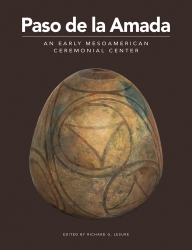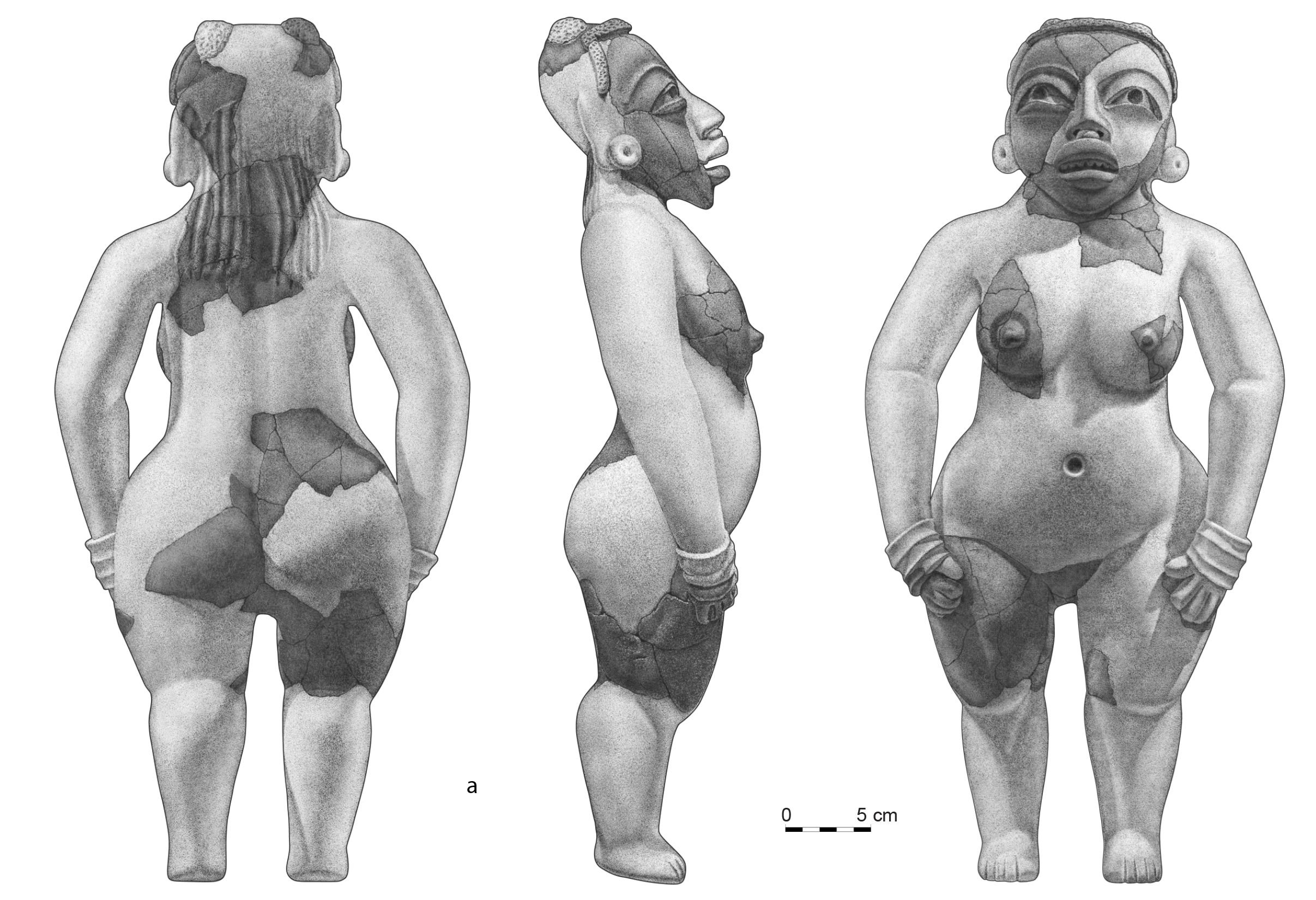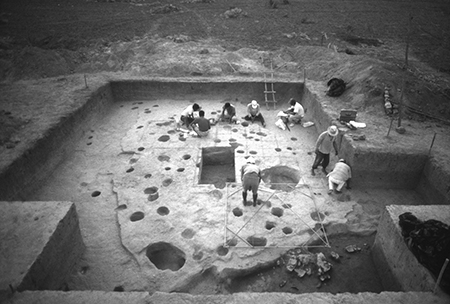Preview of Richard Lesure’s Book on Paso de la Amada Highlights Contributions by UCLA Collaborators

It famously has been said that “it takes a village.” But how did that village develop and what does being part of a village mean? The emergence of village life in Paso de la Amada in Mesoamerica has fascinated Richard Lesure, professor in the Department of Anthropology at UCLA and core faculty member of the Cotsen Institute, during his nearly 30-year research involving this unique site, which was first settled around 1900 BC. His upcoming book, “Paso de la Amada: An Early Mesoamerican Ceremonial Center,” is to be published in the late spring by the Cotsen Institute of Archaeology Press.
Lesure describes the monograph, which was ten years in the making, as his “magnus opus,” containing 27 chapters covering all aspects of excavations and artifacts, including three interpretive chapters concerning subsistence, social inequality, and the organizational history of the site. Lesure holds the Marilyn Beaudry-Corbett Endowed Chair in Mesoamerican Archaeology.
Dissertation research sparks interest in Paso de la Amada
The work for the book actually started with his dissertation research, according to Lesure. He was a graduate student when he began his first involvement in the region of Chiapas in southern Mexico where Paso de la Amada is located. From that initial exposure, he decided to create his own project, which expanded over the years to include a large team of scholars from around the country, many of whom have contributed to the new book. That team included several key researchers from UCLA.
Lesure spent an extraordinary amount of time in the laboratory, he explains, and estimates that they found nearly 1.1 million artifacts. “The amount of artifacts we have is considerable compared to other sites from this era. It is a really significant sample,” he noted.

Cotsen affiliate Tom Wake makes important contributions
Helping examine these artifacts was one of the prime contributors to the volume: Tom Wake, assistant adjunct professor, Department of Anthropology, director of the Zooarchaeology Laboratory, and a core faculty member of the Cotsen Institute. Wake and Lesure have been working together since Lesure first started at UCLA. Wake’s work with faunal bones “is a pretty major achievement,” according to Lesure. “Tom’s got a good handle on changes in animal bones while people were settling down in permanent villages, adopting agriculture as a full focus of their subsistence, and changing what they did in terms of hunting wild animals and raising domesticated animals, like dogs.”
Wake notes that some of the most valuable research he did with Lesure involved investigating traditional fishing practices. Together, they were able to join some local fishermen in their canoes, and it was “really eye-opening in that the technique they are using today is probably not too different from what was being used” during the time of Paso de la Amada “because the catch was so similar to what we see archaeologically.” For the freshwater fish, he explained, “the catch was basically the same from the modern collection compared to the 3000-year-old collection” from Paso de la Amada. Because of his extensive experience in examining faunal remains, Wake was able to identify many species of fish which had been consumed and the remains discarded. Other remains included deer, dog, giant pocket gophers, cottontails, and peccary, as well as some birds. Birds were also used for offerings, according to Wake.
Recent anthropology graduate is co-author of a chapter
Wake and Lesure co-authored a chapter on faunal remains with Katelyn J. Bishop, who received her PhD in anthropology from UCLA in 2019 and had previously written a paper on bird use at Paso de la Amada. Bishop, who describes herself as a zooarchaeologist, was recently named assistant professor at the University of Illinois at Urbana-Champaign. When she originally came to UCLA in 2012, she had applied in order to work with Lesure, Wake and Greg Schachner (currently chair of the Archaeology Program at the Cotsen Institute). “It was Richard who suggested that I pursue my interest in the ritual use of birds in situations of emergent complexity by analyzing avifaunal remains (bird bone) from Paso de la Amada,” she explained. After re-analyzing all of the bird bones that had been excavated from Paso, she concluded that at least some types of birds were a valued ritual resource even in the Early Formative period (1500–900 BC).
“To my knowledge, these are the earliest known bird offerings in structures in Mesoamerica,” she noted. “Many individuals over the years have analyzed subsets of the overall faunal assemblage from Paso de la Amada, but Tom Wake carried out the overwhelming majority of that work. Subsequently, Tom, Richard, and I worked on understanding and exploring that data in the faunal chapter for the volume. Paso de la Amada seems to be a never-ending fount of interesting artifacts for study and insights into the Early Formative period. I think for that reason this book will be an excellent contribution that many of us are excited to see published,” she added.
The second chapter that Wake worked on with Lesure was on bone artifacts. “I’m interested in the manufacturing use of bone artifacts and how that relates to the people they are associated with. I see it as a kind of continuum from hunting. What do you do with the bones? How do you use them? Sometimes, with some animals, the bones are important sources of raw materials,” according to Wake. “One of the really interesting things about Paso de la Amada is all the bone finger rings. They had an industry that involved using string and abrasives and water to saw through hollow deer bones. They could section a single deer femur into 20 rings or more. There is enough data there that we reconstructed a whole production sequence for these finger rings, which many times are very well-finished; even beveled, often with incisions and decorations on the outside. I am not aware of many other sites where you see finger rings from 1400 BC.” Wake even replicated this technique in his laboratory at the Cotsen Institute, acquired deer bones, and used string to saw them.
Subsistence change; household archaeology analyzed
“Subsistence Change at Paso de la Amada and the Development of Agrarian Societies in the Soconusco” is the third chapter that Wake co-authored. Paso de la Amada is located in the Soconusco region of the Pacific coast of Mexico. “This chapter is based more around lifeways and household practice. That incorporates all of the artifact classes together, like ceramics, lithics, and faunal remains; all the artifacts that are found together in a household. The approach that was used at Paso was one of household archaeology,” Wake explained. “We wanted to find individual households and try to understand better day-to-day life by bringing all these artifacts together. This way we get a much more complete picture of what they ate, how they prepared their food, how they threw away their food, and what tools they had. Is there evidence that some households had better food than others, for example. Faunal remains offer another potential avenue to investigate social differentiation and status,” he added.
Wake recalls that he was the “zooarchaeology guy” when Lesure came to UCLA as a “fresh assistant professor. We started working together right away because Lesure said ‘I have some bones that need to be looked at.’ Our academic, collegial relationship has developed from there,” Wake explained. “Paso de la Amada represents one of the really Early Formative period villages in all of Central America. People interested in early village life on other continents would also find this interesting because this is Early Formative for all the Americas.” Wake added that his work on the project continues and that he is drawing from that data to incorporate into a book he is working on.
PhD candidate Reuven Sinensky adds important insights
Another co-author of the chapter on subsistence change is R. J. Sinensky, a PhD candidate at the Cotsen Institute. Sinensky individually wrote a chapter on “Ground Stone Technology and Routine Food Processing at Paso de la Amada,” which Lesure calls “quite an important contribution.” It is only one of two chapters in the book that is not authored or co-authored by Lesure himself.
Lesure explains that “the narrative has recently been that at Paso de la Amada, they weren’t eating that much maize because there were so many wild resources.” Sinensky had been working on early agricultural villages in the American Southwest overlapping in time with Paso de la Amada, according to Lesure. “So I brought Reuven down to look at the grinding stones at Paso.
“Reuven’s reaction was that the tools were very similar to what he was seeing in the Southwest and that they looked like the sort of tools of people who were very committed to maize. We eventually realized that the assemblage of grinding stones at Paso de la Amada represents two different traditions. There is this old tradition, stemming from hunter-gatherer life, using rudimentary tools. But you can separate out a substantial number of the grinding stones that are deliberately manufactured, similar to what is still being used in Mexico today. Before Reuven’s work, people were not sufficiently recognizing that this tradition that would continue on throughout Mesoamerica was already present at Paso.” “The assemblage of grinding tools is really unparalleled for this period of time in Mesoamerica,” according to Sinensky, who studied nearly 1000 grinding tools or what he calls a “robust assemblage".
“My research in the American Southwest focuses on a similar time period when people first started living in these large villages with more complex social organizations. This is a time of great change,” he explained. “Richard knows Paso like the back of his hand, as do Mike Blake and John Clark, two other researchers who were there at the same time I was. They were all incredibly helpful.”
He continued by noting that there was a consensus among archaeologists that people were eating a lot of corn, and that they were grinding corn every day for meals after around 1000 BC. “What I found after surveying these tools is that people were already in the process of shifting to this corn-heavy diet at Paso de la Amada.” He also believes that people were migrating from different areas, converging on this place; and that the shared cuisine was probably a really important part of what allowed people to live in a village together.
Book research is “brilliant and deep”
 Lesure is the first to point out that although his name is on 25 of the 27 chapters, “without the collaboration of other people,” the book “would not have happened.” The extensive research is one of the extraordinary features of the book. “The research for this book is brilliant and deep, and I really think we are presenting it with the excellence it deserves,” according to Randi Danforth, publications director of the Cotsen Institute of Archaeology Press. “The book is beautiful and user-friendly,” she added. “It is very complex, with many high-resolution composite figures, several levels of hierarchy in subheads, tables of data, and all this in 27 chapters.”
Lesure is the first to point out that although his name is on 25 of the 27 chapters, “without the collaboration of other people,” the book “would not have happened.” The extensive research is one of the extraordinary features of the book. “The research for this book is brilliant and deep, and I really think we are presenting it with the excellence it deserves,” according to Randi Danforth, publications director of the Cotsen Institute of Archaeology Press. “The book is beautiful and user-friendly,” she added. “It is very complex, with many high-resolution composite figures, several levels of hierarchy in subheads, tables of data, and all this in 27 chapters.”
Among his many publications, Lesure has two other books published by the Cotsen Institute Press, “Formative Lifeways in Central Tlaxcala Volume 1: Excavation, Ceramics, and Chronology,” and “Settlement and Subsistence of Early Formative Soconusco.” Danforth had worked with Lesure on the former, describing him as “extremely meticulous and responsive.” She noted that once the full manuscript was received, it was peer-reviewed and discussed by the editorial board before being accepted for publication. “I always love working with our Cotsen affiliated faculty, no exceptions. But I never want anyone to think they have a special ‘in’ with us because there is absolutely no mitigation of quality as we consider all proposals equally, from UCLA and outside,” she added.
“Paso de la Amada” will be part of the Cotsen Institute of Archaeology Press Monumenta Archaeologica series, which offers final reports of significant field research presented in hardcover format. Retail price will be $89.00, and the book will be available from the Cotsen Institute Press distributor.
Closer to the publication date in late spring, professor Lesure will be presenting a public lecture about the book and the research projects it reports. Please watch for future notices.
Published on February 18, 2021.


